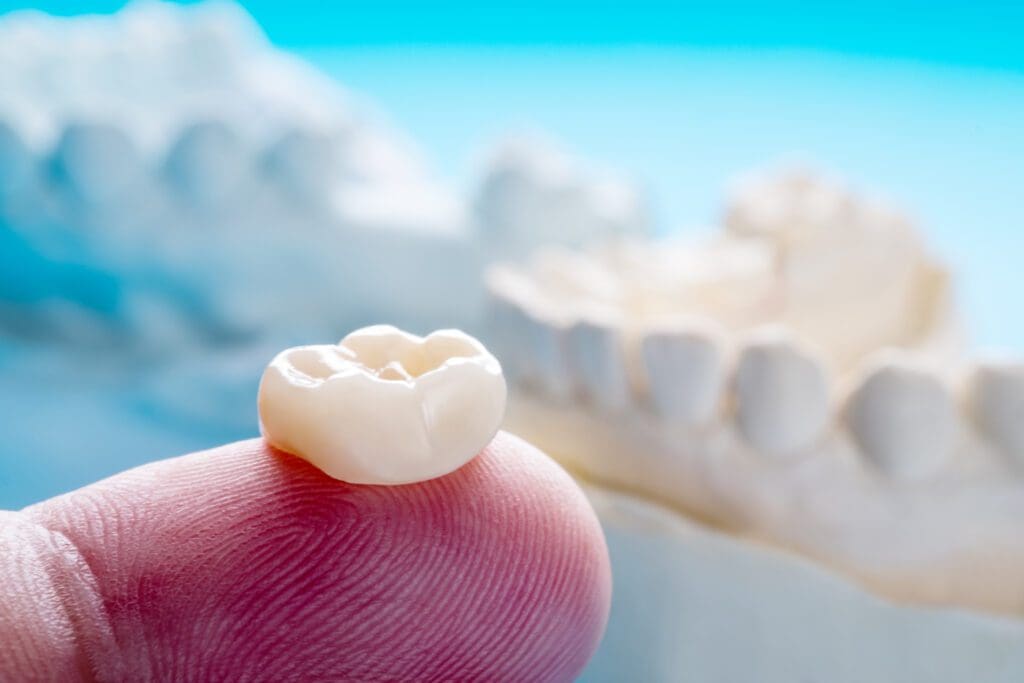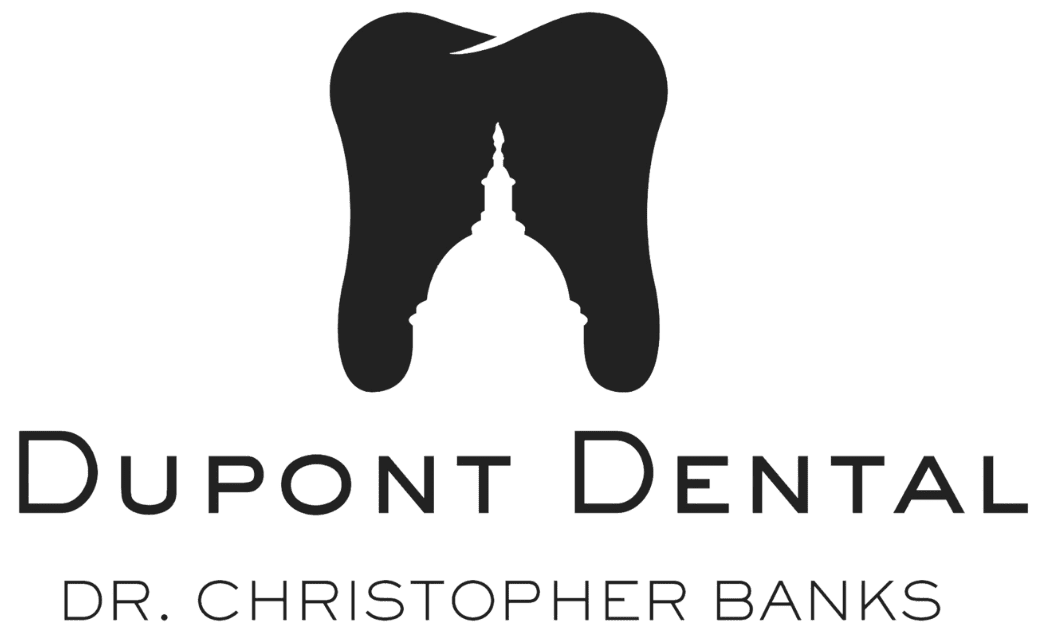Dental crowns are tooth-colored caps that can repair and preserve damaged teeth. A single crown can fit over a tooth to strengthen the tooth and create a natural look. Crowns are designed to fit and blend in with your natural tooth. Dr. Christopher Banks offers dental crown treatment as a restorative dentistry service in his Washington, DC, office. He ensures dental crowns blend in with the smile and create a seamless look.

Why Should You Choose Dental Crowns?
Dental crowns are an excellent solution to repair the appearance and comfort of your tooth. Crowns can last for years, as they are durable and should withstand daily wear and tear. Dental crowns can be made of porcelain, ceramic, glass, or even gold or metal alloy. If you have a missing tooth, our tooth crowns offer a natural-looking and durable solution.
Several types of dental crowns are available, and each type has its own benefits. The most common types include:
- Porcelain Crowns: These crowns are made entirely of porcelain, which gives them a natural look that matches your teeth. They’re great for front teeth because they look very realistic.
- Porcelain-Fused-to-Metal Crowns: PFM crowns have a metal base covered with porcelain. They’re strong and durable, making them good for back teeth where biting pressure is higher. The porcelain on the outside helps them blend in with your natural teeth.
- Metal Crowns: These crowns use metal materials like gold or silver. They’re strong and can withstand a lot of pressure, making them perfect for back teeth. But they aren’t as natural-looking as porcelain crowns.
- Zirconia Crowns: Zirconia crowns are made from a strong, durable material that is also tooth-colored. They’re great for both front and back teeth because they look good and are strong. But these crowns are more expensive than other options. Because they’re so strong, they can damage opposing teeth if they aren’t adjusted carefully.
- Resin Crowns: These crowns are made from tooth-colored materials. They’re usually less expensive than other types, but they may wear down faster and are not as strong as porcelain or metal crowns. We often use resin crowns as temporary crowns.
Our office recommends crowns made of tooth-colored materials because they look more natural. Even if metal crowns are used on the posterior teeth, they are still visible when the mouth is open. Using materials like porcelain or ceramic creates a more seamless look.
Crowns not only cover damaged teeth. Dental crowns can cap off dental implants for patients missing a permanent tooth. Traditional dental bridges use dental crowns to protect teeth on either side of a tooth gap to hold false teeth in place. Crowns have many uses in restorative dentistry while improving the look of damaged and worn teeth.
What Dental Crowns Can Treat
Dental crowns are valuable because they can treat various cosmetic and restorative dental conditions. We can treat many dental concerns with tooth crowns.
Correct Cosmetic Flaws
Everyone will experience discolored teeth at some point. Many times, we turn to professional teeth whitening to correct these issues. But it all depends on the type of discoloration and what caused it. Sometimes, discoloration doesn’t respond to the usual techniques. With a dental crown, we color-match it to the shade of white that you desire. Since it covers the entire tooth, no one will see the discolored one anymore.
When patients come to us with a misshapen or deformed tooth, it’s usually because they aren’t happy with how it looks. However, they can have other impacts. Each tooth has a specific job for chewing your food and working with your tongue to form sounds. Deformed teeth can hinder these things. A dental crown restores the correct shape of the tooth so that it can perform these duties the way it should.
Assist Natural Teeth
One of the most common things we use dental crowns for is stabilizing a tooth after a root canal procedure. When we perform a root canal, we remove infected dental pulp and soft tissue from inside your tooth, refilling it with a biocompatible resin. Sometimes, the tooth doesn’t return to full function. A dental crown ensures you can use it normally while it seals off the tooth from further infection.
A dental bridge replaces multiple consecutive teeth. On each span end, brackets support the dental bridge using the natural teeth. The stress of the dental bridge is a lot for the natural teeth to take. Anchor teeth wear down faster than other teeth and are more susceptible to tooth decay and other problems. If we use crowns on the anchor teeth, the crowns take on the stress and pressure of supporting the bridge instead of your natural tooth structure.
Treat Broken and Decayed Teeth
Crowns are often the last line of defense to keep the natural tooth structure. We want to preserve the tooth root whenever possible to avoid jawbone deterioration and other consequences. A dental crown can keep pieces of a shattered tooth together or replace the portions of your teeth that are gone from decay.
It’s not a big deal when a small chip comes from a tooth. But a large break can cause more problems. It can expose sensitive dental nerves and pulp in the tooth’s center. It can also create sharp edges that can cut into your tongue or the inside of the cheeks. A dental crown protects the nerves and ensures the edges don’t harm soft tissue.
Complete a Dental Implant
A dental implant is the gold standard for replacing missing teeth. When completed with a custom dental crown, it looks and feels the most like a natural tooth. You can eat all the foods you would normally and not have to worry about it harming your restoration.
Dental Crown Treatment in Washington, DC
Dr. Banks must prepare the treated tooth to fit the dental crown properly. He’ll gently etch into the tooth enamel. The amount of enamel removed depends on the thickness of the crown. Then, he’ll take an impression of your tooth, which he sends to a dental technician to create the crown.
Dr. Banks will color-match the tooth so the crown blends in with the smile. He may also make impressions of the jaw opposite of the treated tooth so the crown matches your teeth. Once the crown is complete, Dr. Banks will double-check the shape and size of the crown and make adjustments as needed before cementing the crown to the tooth.
You can care for dental crowns like natural teeth. You can brush and floss your crown using a soft-bristled toothbrush and non-abrasive toothpaste. Tooth crowns can last ten to fifteen years with the proper care. Maintaining a good oral hygiene routine and visiting the dentist regularly will help the crowns stay bright and last.
Patient Review
Frequently Asked Questions
Do you want to learn more? We’re here to help. We have answers to some of the most common patient questions about tooth crowns in Washington, DC.
Can I whiten a tooth crown if it becomes discolored over time?
No, you can’t whiten crowns like your other teeth. Porcelain or ceramic crowns don’t respond to whitening treatments. If your crown becomes discolored, our dentist may need to polish or replace it to restore its appearance. We’ll whiten your natural teeth first and then match a new crown to that shade for a more consistent look.
Can a dental crown fall off or come loose?
A dental crown can fall off or come loose if the cement that holds the crown in place wears out or if the tooth underneath changes. If your crown comes off, don’t try to glue it back yourself. Keep the crown safe and call Dr. Banks. We can clean and reattach your crown in our office. If not, Dr. Banks can make a new one.
Can I get cavities under a dental crown?
Yes, even though the crown covers your tooth, the edge where the crown meets your natural tooth can still collect plaque and bacteria. Decay can form under the crown if you don’t brush and floss regularly. We recommend that you keep your teeth and gums clean and visit our office for regular checkups to prevent cavities.
What signs indicate that a crown needs to be replaced?
You might notice discomfort, sensitivity, or pain around the crown when you bite or chew. Other signs include visible damage, chips, cracks, or darkening near the gum line. You may experience gum inflammation or persistent bad breath if the crown isn’t sealed properly. Regular dental visits help catch these problems early so we can replace your crown before more serious issues happen.
Can crowns be placed on baby teeth in pediatric dentistry?
Yes, severely decayed or damaged baby teeth may need crowns. Stainless steel crowns are common for kids as they’re durable and protect teeth until permanent ones emerge. Crowns also keep baby teeth in place to maintain proper spacing for adult teeth. We can discuss whether a crown is appropriate for your child’s needs.
Will I need a temporary crown while waiting for my permanent one?
Yes, Dr. Banks can provide a temporary crown to protect your tooth while the permanent one is custom-made. This temporary crown shields the prepared tooth. It also helps you chew comfortably and maintain proper spacing. You want to avoid sticky or hard foods to prevent damage. The temporary crown stays in place until your permanent crown is ready within a few weeks.
Does getting a tooth crown hurt?
Getting a tooth crown isn’t painful because our dentist will use local anesthesia to numb the area before the procedure. You might feel some pressure or mild discomfort during tooth preparation, but it shouldn’t be painful. After the procedure, some patients experience temporary sensitivity. This will resolve within a few days to a week.
Will a dental crown affect my speech or how I bite and chew?
A new crown may feel different at first and cause minor adjustments in how you chew or speak. Most people adapt within a few days and the crown feels natural after this short adjustment period. We can make slight adjustments if needed.
Properly placed crowns improve chewing function and shouldn’t negatively affect speech in the long term.
Schedule an Appointment
Do you have a worn or damaged tooth that makes it uncomfortable to bite and chew? Contact Dupont Dental for a dental crown in Washington, DC, today at (202) 946-4720. You may also schedule a dental appointment with Dr. Banks on our website.
